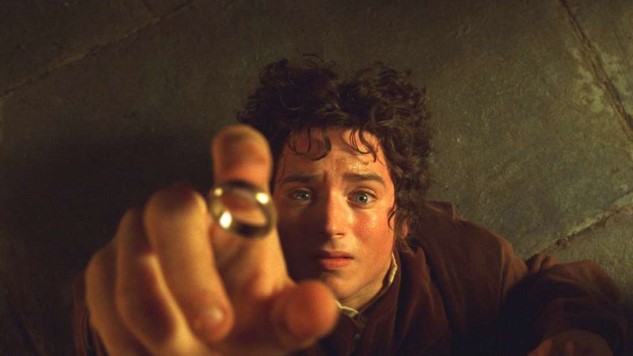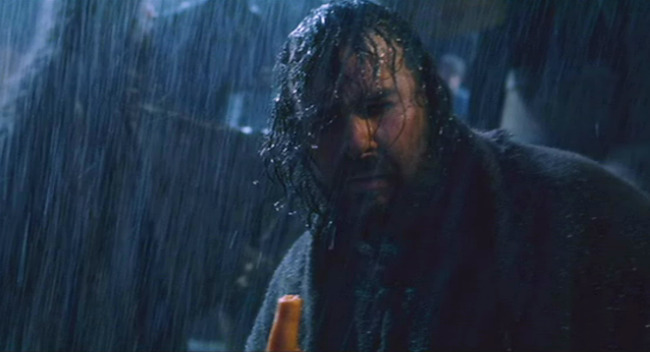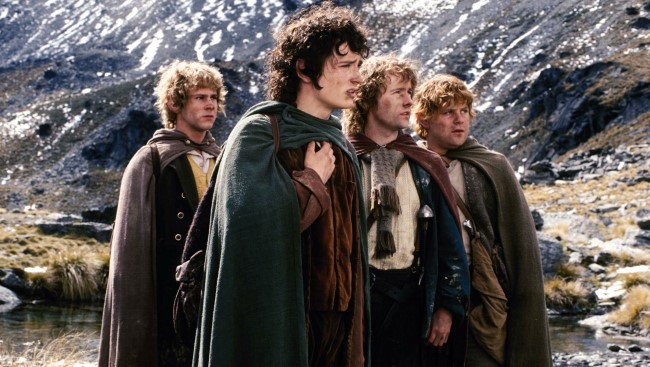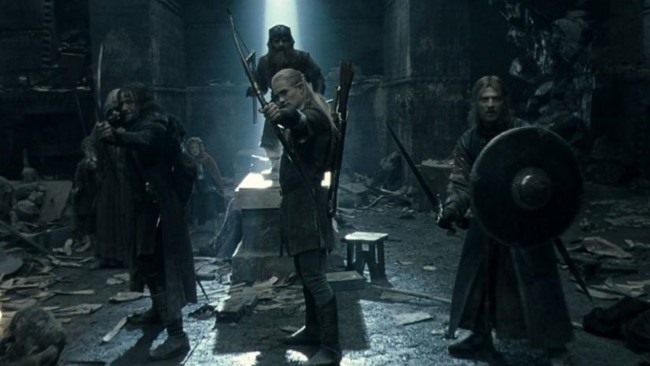
Peter Jackson’s LOTR Was an Improbable Miracle, and We’re Lucky to Have It
by Jim VorelLooking back on director Peter Jackson’s Lord of the Rings trilogy in 2020, some 13 years into what we might as well dub the “Marvel Cinematic Universe Era,” it’s all too easy to make the assumption that a valuable IP like the works of J.R.R. Tolkien was always bound to be adapted into a series of blockbuster smash hits. After all, we now live in a time when seemingly any property with minimal recognizability or cultural cachet has been, or is currently in the process of being shaped into a piece of cinematic confectionary, when the opportunities afforded by a “shared universe” of characters and settings has never been more clear. The Lord of the Rings is the basis for almost the entirety of all modern fantasy fiction tropes—how could it not translate into billions at the box office? Signing off on producing that trilogy must have been the easiest of all decisions, right?
Nothing could be further from the truth. As we begin to approach the 20-year anniversary of The Fellowship of the Ring’s 2001 release, we should recognize just how much hindsight bias is present in how we tend to view Jackson’s trilogy today … not to mention how profoundly different these films would likely have turned out if they began production just a few years later. In fact, as you tally up the factors that were working against Jackson and LOTR at the time, it becomes clear that the eventual faithfulness and smashing success, both critical and commercial, of this trilogy were nothing short of miraculous. Peter Jackson pulled off something nearly impossible, something that would probably never happen today for a bevy of reasons. We should acknowledge just how lucky we are that he made these films exactly when he did.
An Unknown Director, an Undervalued Property
One of the easiest misconceptions regarding the development of the LOTR trilogy is the assumption that studios would have been scrabbling over each other in a fight to be the first to produce such a lucrative IP. Today, we’d look at the collected works of J.R.R. Tolkien’s imagination as a vast, untapped, incredibly valuable suite of cinematic world-building tools, but that’s from the perspective of people who have watched the MCU turn C and D-list superheroes (Drax the Destroyer? Jessica Jones?) into beloved cultural icons in the course of a few films or TV series. Film producers and studios of the late 1990s and early 2000s, on the other hand? They looked at The Lord of the Rings and saw a confusing morass of nerdy, underground niche culture, totally unaware that within a few decades nearly every summer blockbuster was going to be built around properties fitting that exact description. When the average studio exec looked at The Lord of the Rings, the last thing they were seeing was blockbuster material. They saw dusty British—shudder—literature, which was never going to put butts in seats.
It’s absolutely vital to consider the era here. It was the late 1990s when Peter Jackson and Fran Walsh were trying to sell their dream project—an adaptation of Tolkien’s The Lord of the Rings, filmed entirely in Jackson’s native New Zealand, which he recognized would contain all the diversity of scenery necessary to bring Middle Earth to life. We were still a couple years away from the 2000 release of Bryan Singer’s X-Men, which must be considered the starting point for the modern superhero movie genre, and even further from Sam Raimi’s Spider-Man, which would solidify “nerdy” superhero films as bonafide blockbuster material in 2002. Comic books, in this era, were still viewed by the majority of filmgoers (and producers) as the sole domain of the acne-ridden male nerd, rather than fertile ground for mass appeal summer action spectaculars. And something like The Lord of the Rings? Its profile was far lower than even those comic books. It’s a trio of long, unwieldy, densely populated 1950s countercultural novels, in a genre (fantasy) that was largely seen as lacking any form of blockbuster potential. People on the street wouldn’t be expected to know the characters, or be able to grasp all that Elvish nonsense. You can hardly blame a company like Disney for saying, according to Fran Walsh, that “fantasy films don’t make money.”
So that’s strike one—The Lord of the Rings isn’t terribly well known outside of the nerd circles, and few studios are interested in making a commitment to adapt all three books of the series. But at least that potential adaptation has a visionary director attached, right? The presence of Peter Jackson is going to convince producers to take a chance on this, right?

God bless this Kiwi nerd and his carrot-chomping cameos.
Well, not so fast. Today, we associate Jackson with screen epics, whether they’re beloved like LOTR or successful to varying degrees (King Kong, The Lovely Bones, The Hobbit, Mortal Engines), but at the time, the director had made a grand total of ONE film in America. That was 1996’s The Frighteners, a charmingly goofy horror comedy that was the last live-action leading role for Michael J. Fox. Today, that film has something of a cult following, but in 1996 it went more or less unheralded, losing money for Universal and generally being viewed as a disappointment, despite decent reviews. Its budget? Roughly $26 million.
“Not much,” you might be thinking, but that Frighteners budget is massive compared to literally everything else Jackson had been working with in his pre-Hollywood filmmaking career in New Zealand. There, he made four features from 1987 to 1994, for an average of around $2 million. And what were those films like, exactly? Glad you asked.
Feature debut Bad Taste is a $25,000 budgeted sci-fi splatter comedy in which lumpy aliens attack New Zealand and blow various people to bits. Follow-up Meet the Feebles is a legendarily gross and raunchy puppet movie, caricaturing The Muppets by doing things that would make the creators of Team America: World Police do a double take. He then produced zombie comedy Braindead, which is arguably the most purely bloody and gory film ever made, before gaining his first critical acclaim with Heavenly Creatures, a drama about a notorious 1950s New Zealand murder case.
This is the guy who was then given more than $280 million to direct a simultaneously shot film trilogy of The Lord of the Rings. To say that Peter Jackson had never even attempted something halfway comparable before in his career, in terms of either scale or tone, is a gross understatement. It was a massive risk to hand the keys of this franchise over to him—the equivalent of Marvel Studios hiring someone like Eli Roth to direct The Avengers immediately after seeing his work on Cabin Fever and Hostel. One wonders if most of the producers Jackson was speaking to had even seen the likes of Meet the Feebles, and if they would have dared to hand him the works of J.R.R. Tolkien if they’d seen sequences like the climactic lawnmower zombie massacre of Braindead. To think that the same man was responsible for both this gory insanity and a fully realized Lord of the Rings adaptation seems truly impossible.
Perhaps unsurprisingly, then, Jackson faced a total lack of interest from most American studios as he tried to fight for an LOTR film series, never hearing back from the vast majority of places he pitched. Others, like Harvey Weinstein’s Miramax, expressed interest, but with crippling caveats: They wanted him to tell the entire story within the context of a single film. Weinstein, in fact, threatened that if Jackson couldn’t make LOTR as a single film, he’d snap up the rights and have director John Madden—of Shakespeare in Love and The Best Exotic Marigold Hotel—captain the resulting clusterfuck. Give thanks to God that we didn’t see that happen, although it could have made for a mess of legendarily entertaining proportions.

Then again, Weinstein also reportedly wanted to kill off at least one hobbit, so perhaps we shouldn’t be surprised that he had some bad ideas about this franchise.
It wasn’t until Jackson brought the film to his absolute last chance, New Line Cinema, that he found a receptive audience—and that was only after employing a strategy to drum up interest by repeatedly rescheduling the meeting to make himself seem far more busy and sought-after than he actually was. This is how he put it in an interview with Indiewire:
And we put this whole pretense on that this project was so eagerly sought after [laughs], which is complete crap. And we went into New Line’s office at the end of that week, and the credit really ultimately belongs to Bob Shaye who was the head of New Line at that stage. He looked at the reel and said, “You know, what I don’t get is why you want to do two films.” And we thought, “Oh, here we go. He’s going to try to make us do one film now. The same story.” But the very next thing he said was, “Why would you do two films when there’s three books? Why wouldn’t you do three films?” And that was the way he took the project on.
Finally, against all odds, Jackson was going to get his shot at a Lord of the Rings trilogy. But how do you adapt something that many consider to be unadaptable?
Translating Tolkien for the Screen
A lot of credit for the success of The Lord of the Rings tends to be awarded to Jackson as director, or the series’ performers, or the game-changing VFX work of New Zealand’s Weta Workshop. An aspect that gets left out more often, on the other hand, is the work of Jackson, Walsh, Philippa Boyens and Stephen Sinclair in taking a mountainous pile of fantasy literature, written by Tolkien over the course of 12 years (in which time the author’s worldview evolved significantly), and turning it into a more easily digested and understandable screen story. In order to make LOTR flow as a proper film trilogy, Jackson and co. performed major narrative surgery on a daily basis, excising entire subplots, streamlining and condensing characters, but also inventing from the whole cloth in ways that now feel indispensable to the films when you watch them today. In the process, they pulled off what is rightfully regarded as one of the most successful literary adaptations of all time, both preserving the spirit of the source material and discarding those elements that would have held back the films.
In doing so, Jackson displayed frankly incredible instincts for where he should condense, shuffle, add or subtract material from Tolkien’s difficult, nonlinear story—instincts that you certainly wouldn’t have expected from a guy who less than a decade earlier based his zombie comedy around a diseased “Sumatran rat-monkey.” Take these decisions, for instance:
— Jackson and his writers recognized how poorly served the character of Arwen was in Tolkien’s source material, appearing only twice in the books as little more than window dressing. So they killed two birds with one stone, combining her character with others from the book to not only make her more of an active participant in the war for Middle Earth, but also enriching her decision (and Aragorn’s inner turmoil) to choose a mortal life rather than sail away to the West to live in bliss. For all its wonderful qualities, LOTR will never be a series that is great about egalitarianism, but some tweaks to Arwen and Eowyn at least went a long way in helping in this regard.
— The writers also observed that despite being almost a co-main character, Aragorn possesses little of a genuine character arc in Tolkien’s original novel—he’s simply a very noble man and warrior who seems determined from the first moment we meet him to reclaim the throne of Gondor. Jackson seemed to realize that this version of Aragorn would come off as entirely too elitist in a story that required him to be relatable and resistant toward leadership. The films’ Aragorn, then, is a man full of self doubt and fear of the original sin—Isildur’s weakness—in his blood, who gradually comes to terms with the fact that he must take the mantle of leadership or watch his world be destroyed. It makes Aragorn a much more compelling character than he would be otherwise if he haughtily proclaimed his nobility from the start. And let’s not even get started on the fact that Aragorn was originally to be played by a fresh-faced Stuart Townsend, before Jackson realized he lacked the gravity and experience the role required.
— Although these decisions were all heavily scrutinized by LOTR geeks at the time, Jackson seemed to have little trouble knowing which subplots to excise, whether it’s the trip to Tom Bombadil’s house in Fellowship or that odd little dalliance with the Drúedain and Ghân-buri-Ghân in Return of the King. Some of this type of material was added back in each film’s Extended Edition release, but in each case of a major subtraction, it’s easy to see in hindsight how it served the main focus of the story: the journey of the ring to Mordor.

With the occasional action sequence to keep the audience awake, of course.
— Even better was the fact that Jackson was able to resist some of the temptations (and even directives) he was faced with during the course of production—notably, the fact that he actually shot an Aragorn vs. Sauron combat scene in a physical battle before the Black Gates at the end of Return of the King, before realizing that such a literal good-vs-evil showdown was more the stuff of bad Y.A. fiction than Tolkien’s vision. This quote from Jackson, in the ROTK bonus features, truly demonstrates his instincts for and understanding of these characters: “We realized it was actually totally demeaning to what Aragorn was doing … Aragorn’s heroism is not a one-on-one duel with a big villain. His heroism is his attempt to put his own life on the line in the vague hope that it somehow may give Frodo and Sam that little opportunity.”
Time and time again, Jackson and the writers of the LOTR trilogy defied the odds to deliver a product that worked both for Tolkien purists and people who had never even heard of a hobbit.
Could You Make Peter Jackson’s LOTR Today?
As soon as you go back and rewatch these three films, there’s a lot that immediately stands out about how differently they were made than what has since become commonplace for comparable tentpole blockbusters.
One has to assume that in a post-MCU world, a first-time film adaptation of The Lord of the Rings would have been treated like a potential goldmine, and never handed to a director like Peter Jackson—someone who possessed seemingly so little applicable experience, despite his deep and abiding passion for the source material. Yes, Marvel films, Godzilla films and even Star Wars entries have occasionally been handed to relatively untested indie directors in recent years, some who have ended up fired as a result, but an entire trilogy, adapting what would now be seen as a motherlode of IP that is ripe for exploitation? If all three entries in a series as important as Disney’s Star Wars sequel trilogy were written and directed by different people, to deleterious result, then one can only imagine how badly the tonal whiplash of jumping from director-to-director might have marred LOTR.
Moreover, in an MCU-concurrent timeline, it also makes sense to assume that there would have been far more studio pressure on creators to not only fill their film with marketable faces, “rising stars” and brand-name performers, but also open up countless avenues for spin-offs within the TCU—which of course stands for the Tolkien Cinematic Universe. Sure, Amazon still has their Lord of the Rings TV series on the way, but there’s no way a series like that would be arriving almost two decades after the fact, if LOTR was just being produced for the first time now. Rather, the spin-offs would practically be the reason for doing the trilogy in the first place. We’d all be watching that delightful single-woman adventure series Eowynning on Disney+, or Wraith Hunters on Hulu. Who knows what other abominations Hollywood would have wrought, if given the chance?
Ultimately, we’re lucky that none of this came to pass, because Peter Jackson’s The Lord of the Rings arrived at exactly the correct moment to both take advantage of technological breakthroughs and not be hamstrung by the formulaic approach toward nerd IP adaptations that developed in the wake of modern superhero films like X-Men, Spider-Man and the eventual MCU. In fact, Jackson may have gotten his project off the ground just in time: Bryan Singer’s X-Men started production a mere 19 days before Peter Jackson’s concurrent shoot of all three LOTR entries.
A little earlier, or a little later, and there’s every reason to think we might have been robbed of so much that went right in one of the greatest adaptations of all time.
Jim Vorel is a Paste staff writer and resident Tolkien geek. You can follow him on Twitter for much more film writing.